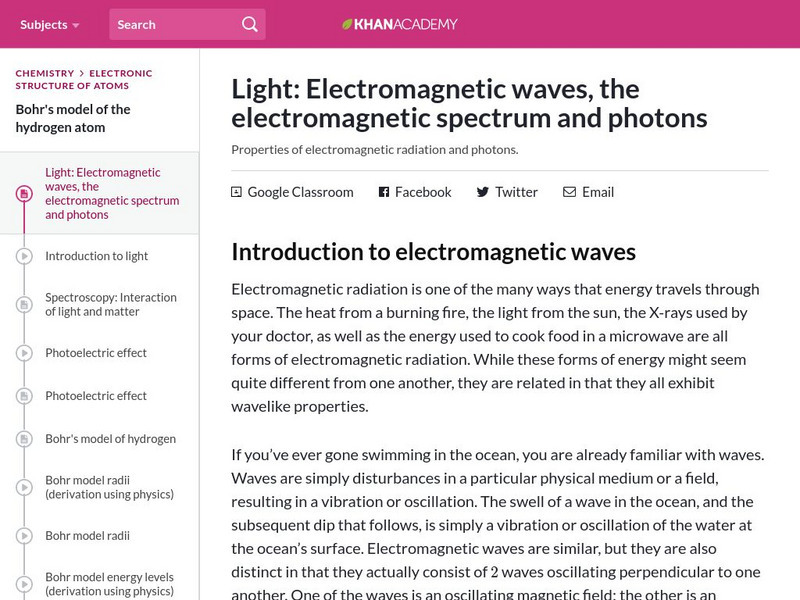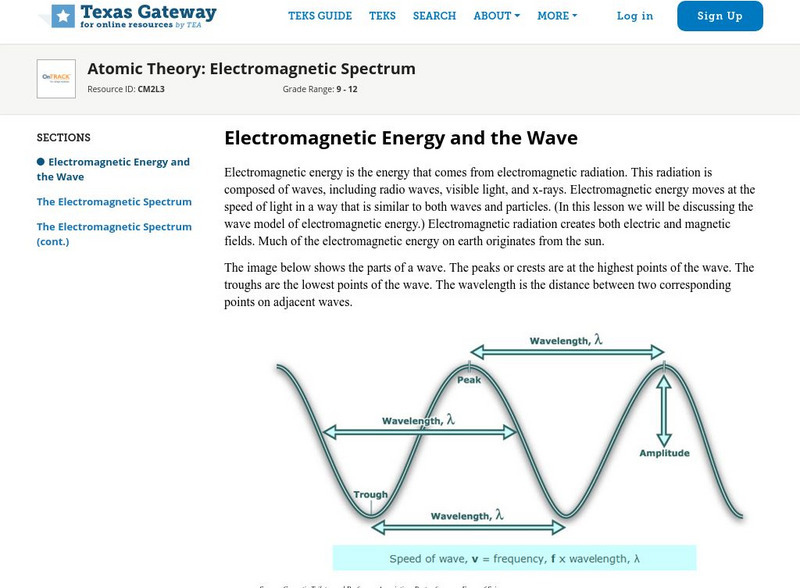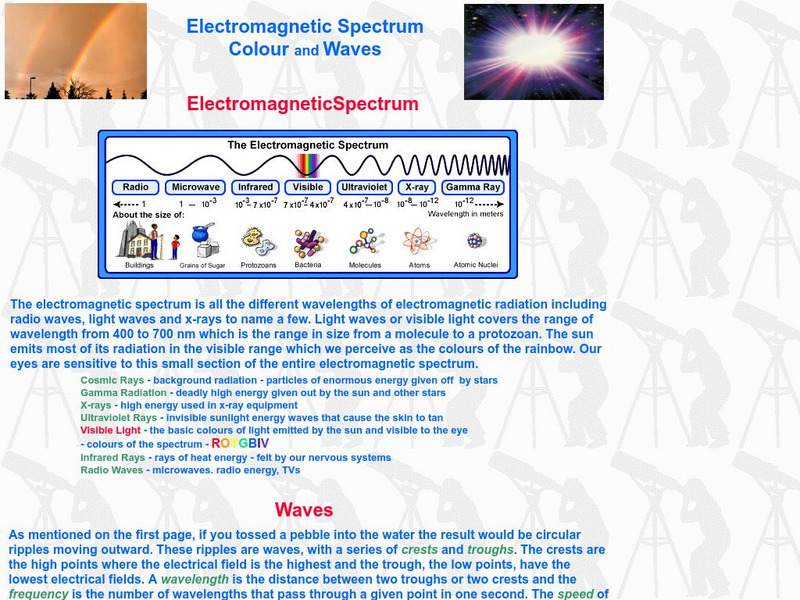Curated OER
Color Recognition
Students envision how space observatories make use of monochromatic filters to collect data on the color of objects in space. They see the actual colors of objects when they are in monochromatic light.
Curated OER
Twisted Vision
Students explain polarization vision and why some animals have it while others do not. They examine the reasons why it would be helpful for marine organisms to have polarized light.
Curated OER
Good Vibrations
Students demonstrate sound waves and make changes in the waves
resulting in changes in pitch. Students associate changes in pitch in various "musical instruments"with size and shape and the sound waves they produce.
Curated OER
Star Power! Discovering the Power of Sunlight
High schoolers estimate the energy output of the sun. They estimate how much power sunlight the sunlight provides to the earth. They build a simple device to measure the amount of solar radiation the earth receives from the sun.
Curated OER
The AM Radio: An Exploration of Communication Using Radio Waves
Students examine the components that are used to make a primitive AM radio. In circuit and radio construction students often are asked to assemble parts are or what function they perform. They examine each main component on an individual...
Curated OER
Naturally Magnetic Elements
Students explore naturally magnetic elements. In this magnets lesson, students examine the periodic table of elements. Students discover the parts of an atom and determine which three elements are magnetic.
Curated OER
Honors Chemistry I
In this honor chemistry I worksheet, students use all available resources to answer each question given. Students apply their knowledge of light, quantum theory of light, Bohr's model, photoelectric theory.
Curated OER
(S-4) The Many Colors of Sunlight
Students observe and explore the characteristics of light.
Curated OER
Popcorn Science
Students identify and apply the scientific method through an experiment with popcorn. Then they identify what independent, dependent, and control variables are and create a list of different variables that affect popcorn popping....
Curated OER
Reflect and Refract
Students explore light. In this properties of light lesson plan, students define the terms refract, reflect, and diffract after listening to the teacher's description. Students listen to the book Light Magic and observe a spoon in a...
Curated OER
Lenses
Students explore vision by experimenting with lenses in equipment. In this optics instructional activity, students define the different technology that enhances vision such as microscopes, telescopes and cameras. Students experiment with...
Curated OER
The Lives of Stars
In this stars worksheet, students review what makes up a star, how astronomers learn about stars, and the different types of stars including low mass and high mass stars. This worksheet has 62 fill in the blank statements.
Khan Academy
Khan Academy: Electromagnetic Waves: The Electromagnetic Spectrum and Photons
An article that discusses the coupling of an electric field with a magnetic field to create electromagnetic waves. Article also discusses how different types of electromagnetic waves have different wavelengths which forms the...
PBS
Pbs Learning Media: The Electromagnetic Spectrum: Frontline
This video segment adapted from FRONTLINE introduces the electromagnetic spectrum and explains how the various types of electromagnetic waves are distinguished by the amount of energy each wave carries.
Texas Education Agency
Texas Gateway: Atomic Theory: Electromagnetic Spectrum
This tutorial reviews the electromagnetic spectrum.
TeachEngineering
Teach Engineering: Exploring the Electromagnetic Spectrum
Students learn the basics of the electromagnetic spectrum and how various types of electromagnetic waves are related in terms of wavelength and energy. In addition, they are introduced to the various types of waves that make up the...
CK-12 Foundation
Ck 12: Physical Science: Electromagnetic Spectrum
[Free Registration/Login may be required to access all resource tools.] Covers electromagnetic radiation and its properties, and the electromagnetic spectrum.
CK-12 Foundation
Ck 12: Earth Science: Study of Space by the Electromagnetic Spectrum
[Free Registration/Login may be required to access all resource tools.] Overview of the electromagnetic spectrum.
NASA
Nasa: Tour of the Electromagnetic Spectrum: Visible Light
Visible light waves are the only electromagnetic waves we can see. We see these waves as the colors of the rainbow. Each color has a different wavelength. Red has the longest wavelength and violet has the shortest wavelength. When all...
NASA
Nasa: Imagers: The Electromagnetic Spectrum
NASA site provides information on waves, electromagnetic waves and their wavelengths.
Texas Education Agency
Texas Gateway: Electromagnetic Spectrum Introduction
A tutorial giving the basics of an electromagnetic wave.
My Science Site
Electromagnetic Spectrum: Colour and Waves
This resource provides information on the different wavelengths that make up the electromagnetic spectrum. Also contains information on waves and color.
NASA
Nasa: Mission: Science: Electromagnetic Spectrum: Infrared Waves
Infrared light lies between the visible and microwave portions of the electromagnetic spectrum. Infrared light has a range of wavelengths, just like visible light has wavelengths that range from red light to violet.
NASA
Nasa: Electromagnetic Spectrum: Radio Waves
Radio waves have the longest wavelengths in the electromagnetic spectrum. This NASA article discusses AM, FM, TV, cell phone, as well as radio astronomy, which all use this technology.



















